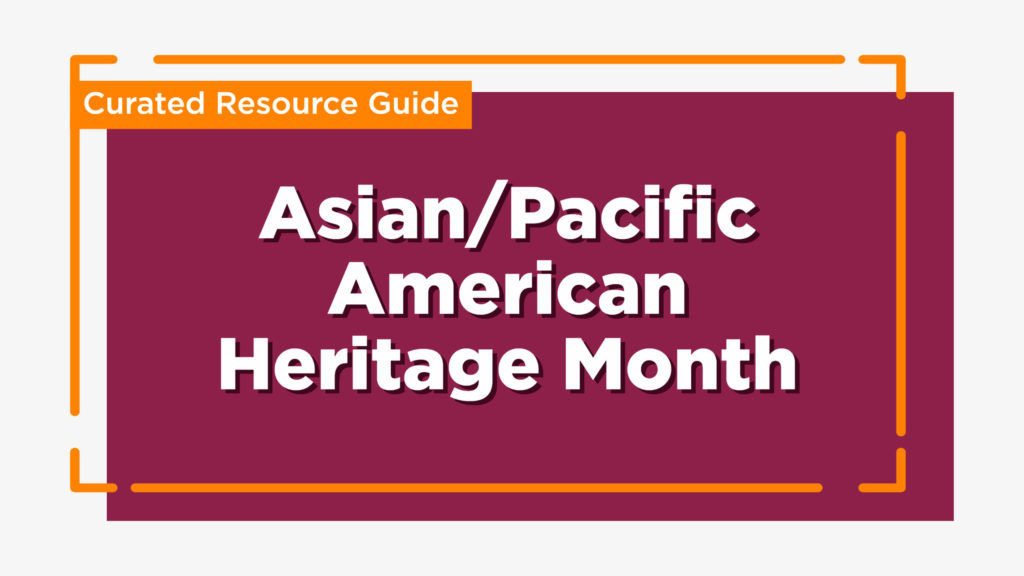May is Asian/Pacific American (APA) Heritage Month, a celebration of Asian and Pacific Islander peoples within the United States. This month highlights the stories and experiences of those individuals with ties to the Asian continent and the Pacific Islands of Melanesia, Micronesia, and Polynesia. The United States (U.S.) Congress chose May as APA Heritage Month to commemorate the immigration of the first Japanese peoples to the U.S. on May 7, 1843, and the anniversary of the transcontinental railroad on May 10, 1869, as Chinese immigrants worked to lay the tracks.
To recognize and celebrate this month, CEHHS curated a list of resources centering APA voices and stories. These resources are available through the UT Library and online.
2024 Updated Resources: Advancing Leaders Through Innovation
Advancing Leaders Through Innovation, the 2024 theme for Asian American Pacific Islander Heritage Month, actively celebrates the pioneering spirit and contributions of Asian American, Native Hawaiian, and Pacific Islander communities. This theme pays homage to the visionaries who have actively shaped American history, while also spotlighting the ongoing influence of APA leaders in propelling economic prosperity, advancing technological innovations, and driving social change. It stands as a tribute to their resilience and creativity, which have enabled them to overcome cultural and systemic barriers, and it actively inspires future generations to carry forward this legacy of innovation and leadership.
Asian American History | Podcast – Gen and Ted Lai
From a Native Daughter: Colonialism and Sovereignty in Hawai’i | Physical Book | E-Book – Haunani-Kay Trask
Heartbeat of Struggle: The Revolutionary Life of Yuri Kochiyama | Physical Book – Diane Carol Fujino
Untold. Patsy Mink: Groundbreaking Congresswoman | Video – Makematic Production Company
Visible Together: An AANHPI Conversation with NASA | Video – NASA
2023 Highlighted Resources
- 31 Stories for 31 Days of AAPI Heritage Month | Multimedia
- Asian American histories of the United States | E-Book
- Time Is a Mother by Ocean Vuong | Physical Book
- We Are American and We Stand Together: Asian American Resilience & Belonging | Video
2022 Highlighted Resources
East Asia
East Asia encompasses the region in the eastern Asian continent. This region includes locations such as China, Hong Kong, Japan, Macau, Mongolia, North Korea, South Korea, and Taiwan. One of the earliest areas of civilization in the world, East Asia holds a rich history and cultural traditions.
- A History of East Asia: From the Origins of Civilization to the Twenty-First Century
- Building Sustainability in East Asia: Policy, Design and People
- East Asia in the World: An Introduction
- Gender, Health, and History in Modern East Asia
- Overcoming Empire in Post-Imperial East Asia: Repatriation, Redress and Rebuilding
- Little Fires Everywhere by Celeste Ng
- Pachinko by Min Jin Lee
- The Astonishing Color of After by Emily X. R. Pan
- The Woman Warrior: Memoirs of a Girlhood Among Ghosts by Maxine Hong Kingston
Southeast Asia
Southeast Asia includes the region south of China, east of the Indian subcontinent, and north-west of Australia. This region consists of both continental or “mainland” zone and archipelago or “island” zone. Southeast Asia includes locations such as Brunei, Cambodia, East Timor, Indonesia, Laos, Malaysia, Myanmar, the Philippines, Singapore, Thailand, and Vietnam. Considered one of the most diverse regions on earth, Southeast Asia developed small cultural niches and feels cultural influences from Islam, India, and China.
- A Blind Earthworm in the Labyrinth by Veeraporn Nitiprapha
- First They Killed My Father: A Daughter of Cambodia Remembers by Loung Ung
- The River of Lost Footsteps: Histories of Burma by Thant Myint-U
- The Sympathizer by Viet Thanh Nguyen
- When Heaven and Earth Changed Places: A Vietnamese Woman’s Journey from War to Peace by Le Ly Hayslip
South Asia
South Asia encompasses the southern region of Asia on the Indian Plate and bordering the Indian Ocean. This region includes locations such as Afghanistan, Pakistan, India, Nepal, Bhutan, Bangladesh, the Maldives, and Sri Lanka. Once home to the Indus civilization, this densely populated region is unified by common languages, ancient textual literature, and cultural/ethical ideals.
- A Companion to South Asia in the Past
- Fierce Enigmas: A History of the United States in South Asia
- Modern South Asia: History, Culture, Political Economy
- Negotiating Languages: Urdu, Hindi, and the Definition of Modern South Asia
- South Asia in Transition: An Introduction to the Social Anthropology of a Subcontinent
- Exit West by Mohsin Hamid
- Family Life by Akhil Sharma
- Kartography by Kamila Shamsie
- Suncatcher by Romesh Gunesekera
- The Inheritance of Loss by Kiran Desai
Pacific Islands
The Pacific Islands reside in the Pacific Ocean. Melanesia, Micronesia, and Polynesia encompass the three major island groups.
This region consists of over 2,000 islands north and northwest of Australia spanning from New Guinea to the Arafura Sea.
- Fiji
- New Caledonia
- Papua New Guinea
- Solomon Islands
- Vanuatu
Approximately 2,100 islands create the Micronesia region. These islands reside between the Philippines and Hawaii.
- The Caroline Islands
- The Gilbert Islands
- The Mariana Islands
- The Marshall Islands
- Nauru
Scattered over the central and southern Pacific Ocean, this region includes over 1,000 islands. This triangle region forms between the Hawaiian Islands, New Zealand, and Easter Island.
- American Samoa
- Cook Islands
- East Islands
- French Polynesia
- Hawaii
- New Zealand
- Niue
- Norfolk Island
- Pitcairn Islands
- Rotuma
- Samoa
- Tokelau
- Tonga
- Tuvalu
- Wallis and Futuna
- Blu’s Hanging by Lois-Ann Yamanaka
- Language of the Geckos: And Other Stories by Gary Pak
- Pounamu, Pounamu by Witi Ihimaera
- The People in the Trees by Hanya Yanagihara
- Turnings: Fiji Factions by Brij V. Lal
Curated May 2021 by Miranda N. Rutan, Doctoral Student, CEHHS A&E, UT Knoxville | Updated May 2024 by Miranda N. Rutan, Doctoral Candidate, CEHHS A&E, UT Knoxville
